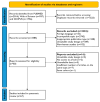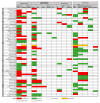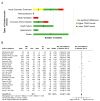Unravelling the Gut Microbiome Role in Cardiovascular Disease: A Systematic Review and a Meta-Analysis
- PMID: 38927134
- PMCID: PMC11201797
- DOI: 10.3390/biom14060731
Unravelling the Gut Microbiome Role in Cardiovascular Disease: A Systematic Review and a Meta-Analysis
Abstract
A notable shift in understanding the human microbiome's influence on cardiovascular disease (CVD) is underway, although the causal association remains elusive. A systematic review and meta-analysis were conducted to synthesise current knowledge on microbial taxonomy and metabolite variations between healthy controls (HCs) and those with CVD. An extensive search encompassing three databases identified 67 relevant studies (2012-2023) covering CVD pathologies from 4707 reports. Metagenomic and metabolomic data, both qualitative and quantitative, were obtained. Analysis revealed substantial variability in microbial alpha and beta diversities. Moreover, specific changes in bacterial populations were shown, including increased Streptococcus and Proteobacteria and decreased Faecalibacterium in patients with CVD compared with HC. Additionally, elevated trimethylamine N-oxide levels were reported in CVD cases. Biochemical parameter analysis indicated increased fasting glucose and triglycerides and decreased total cholesterol and low- and high-density lipoprotein cholesterol levels in diseased individuals. This study revealed a significant relationship between certain bacterial species and CVD. Additionally, it has become clear that there are substantial inconsistencies in the methodologies employed and the reporting standards adhered to in various studies. Undoubtedly, standardising research methodologies and developing extensive guidelines for microbiome studies are crucial for advancing the field.
Keywords: cardiovascular disease; dysbiosis; meta-analysis; metabolites; microbiome; microbiota; systematic review; trimethylamine N-oxide.
Conflict of interest statement
The authors declare no conflicts of interest.
Figures






References
Publication types
MeSH terms
Substances
Grants and funding
LinkOut - more resources
Full Text Sources

